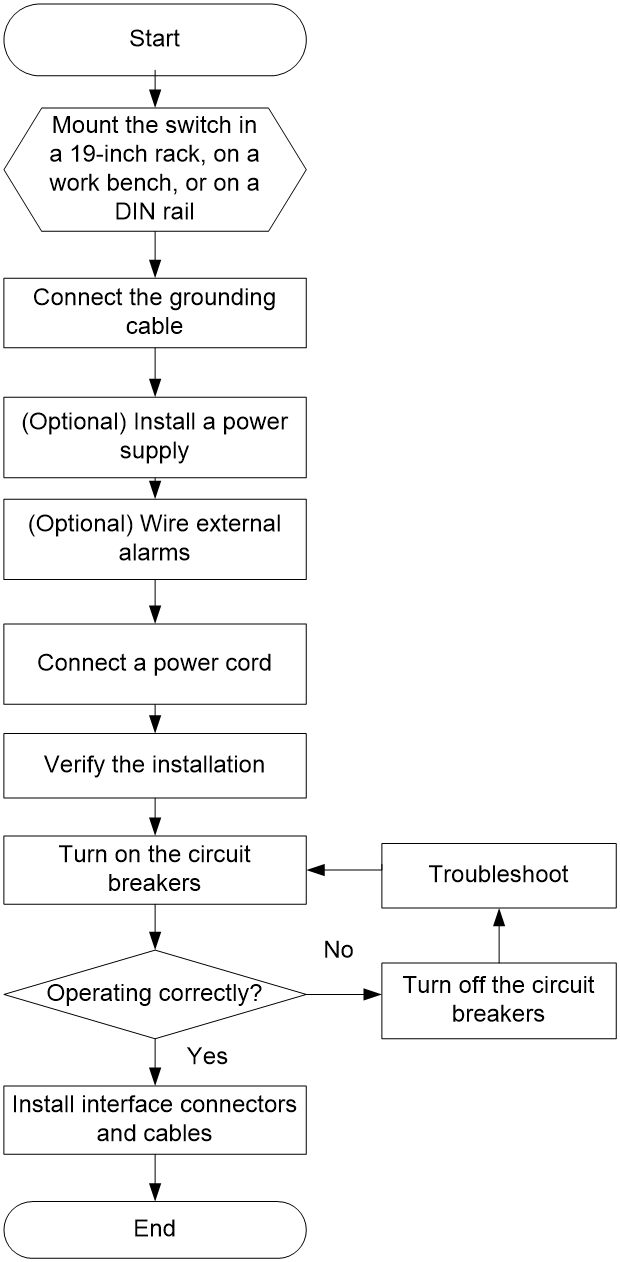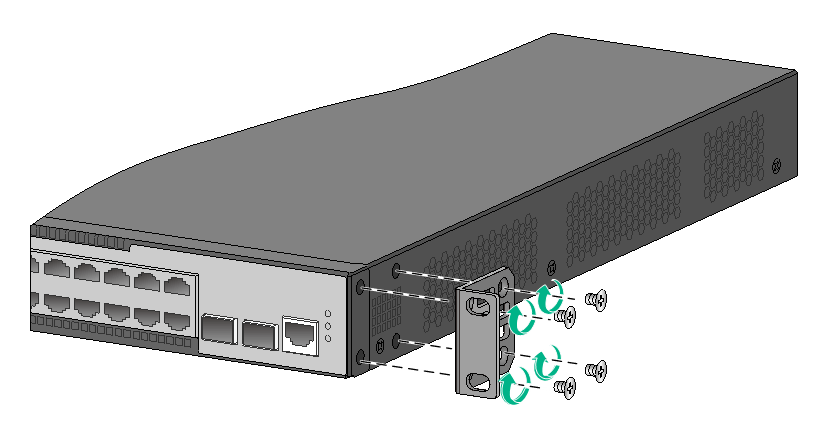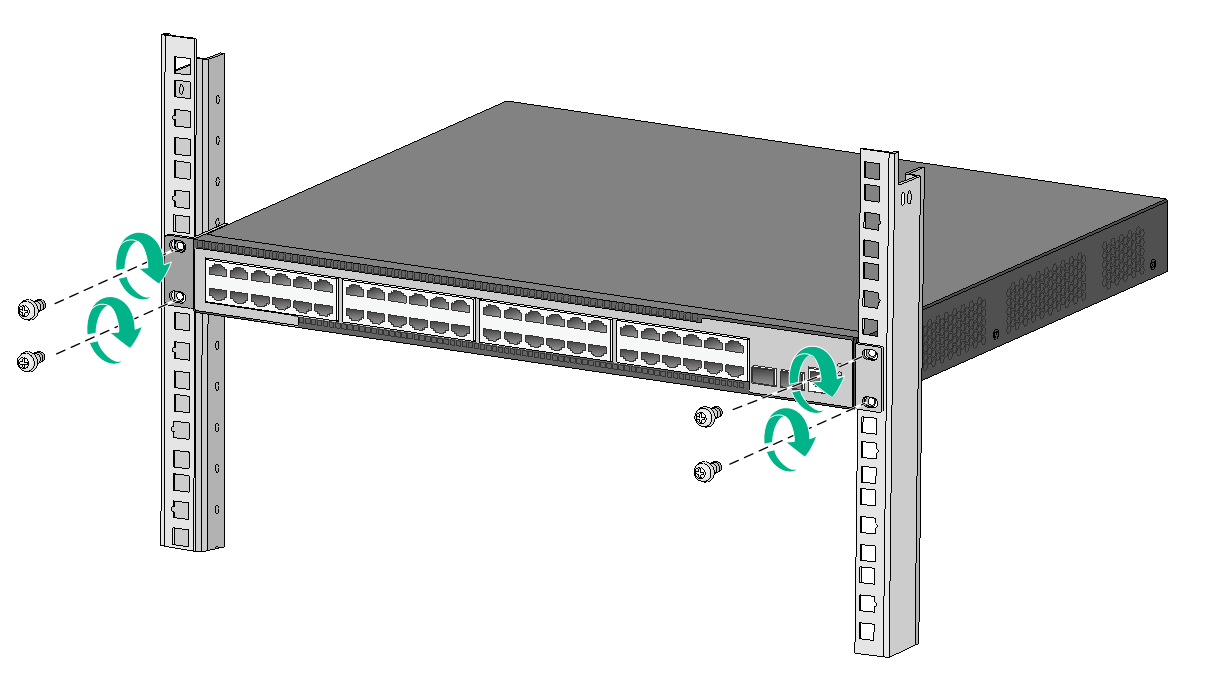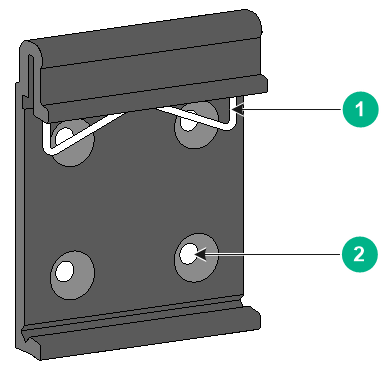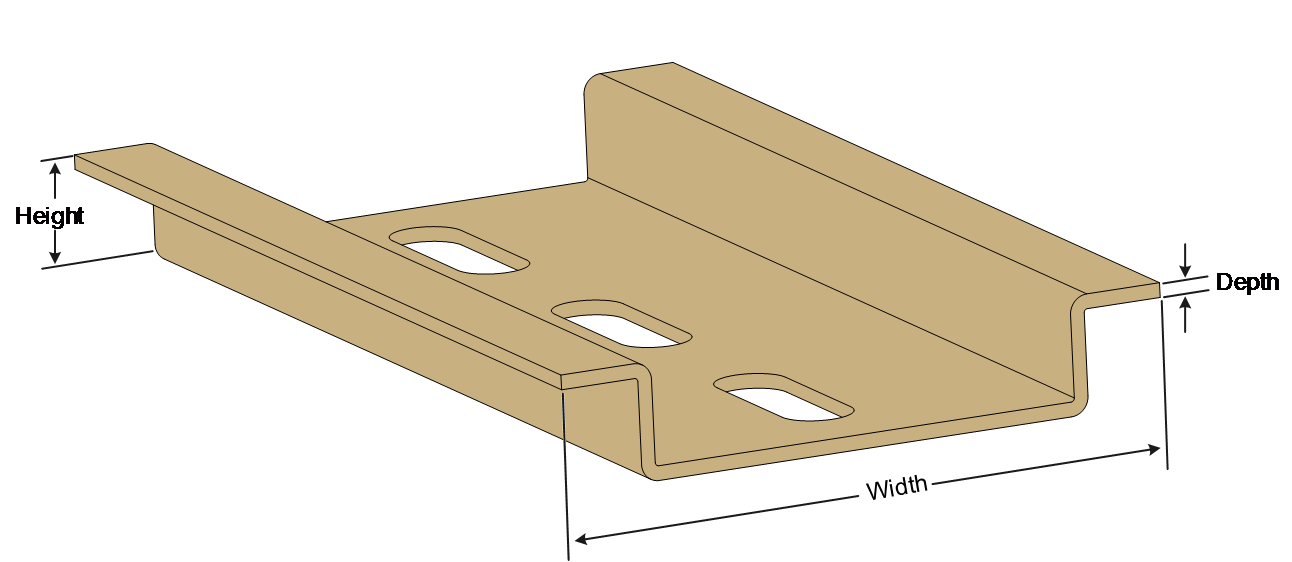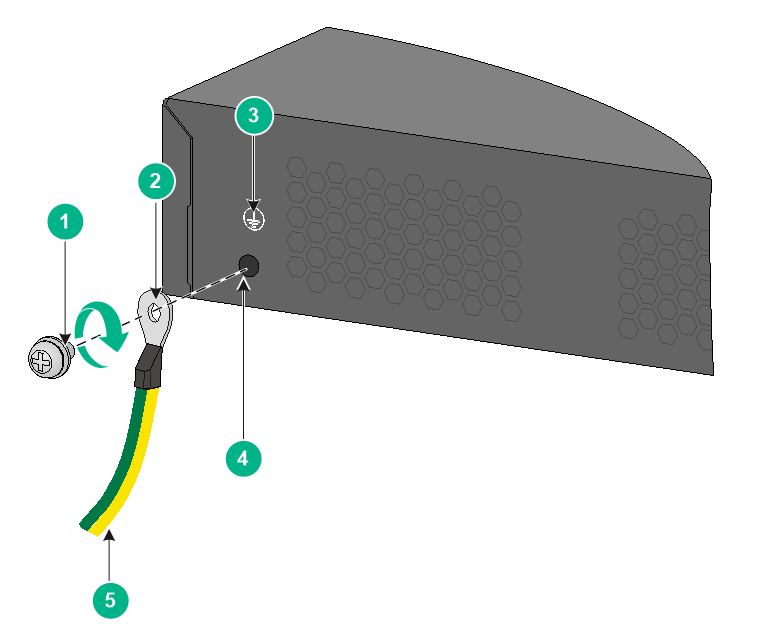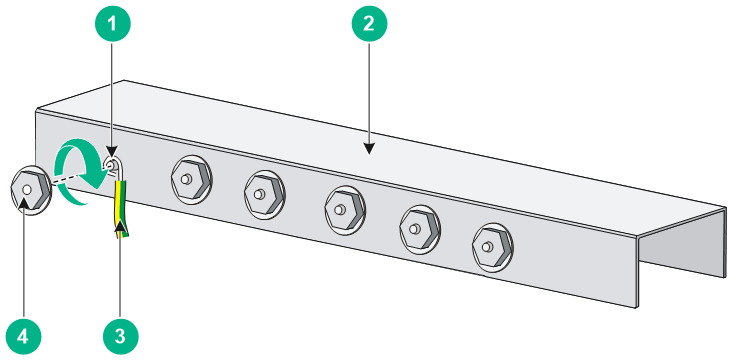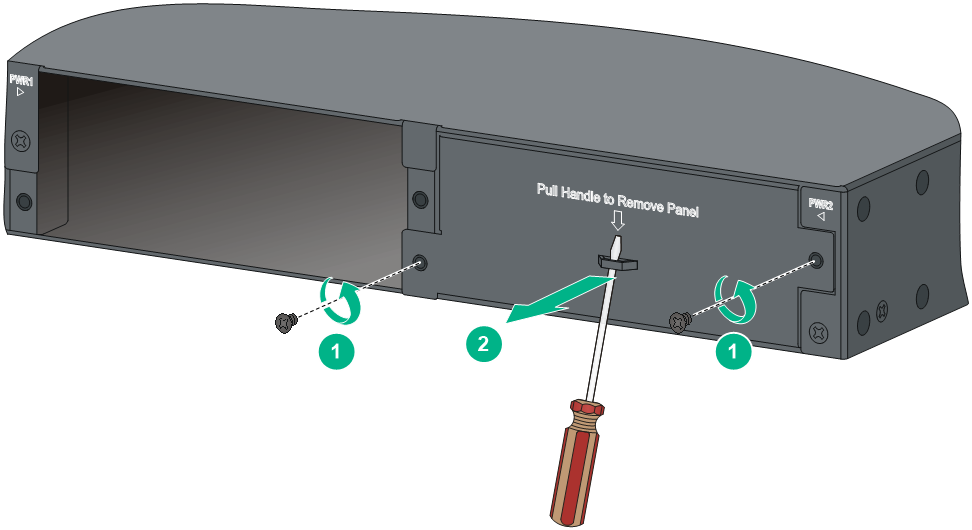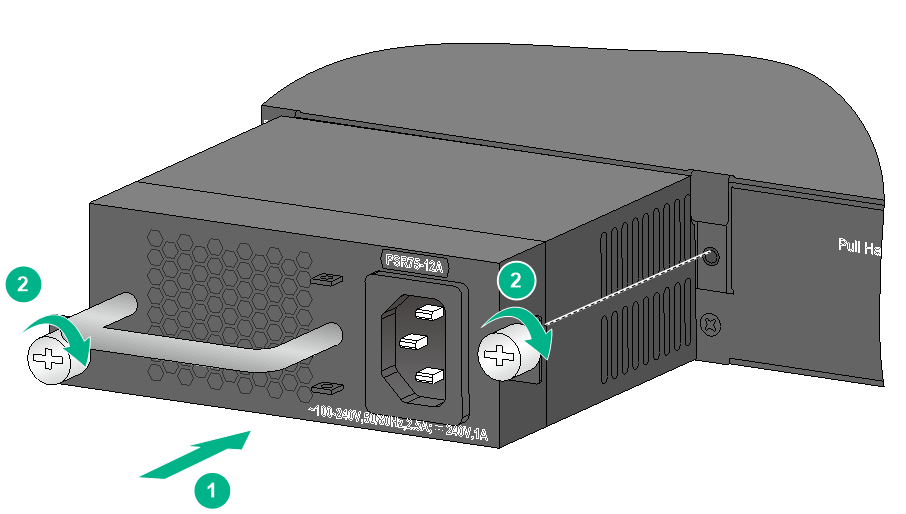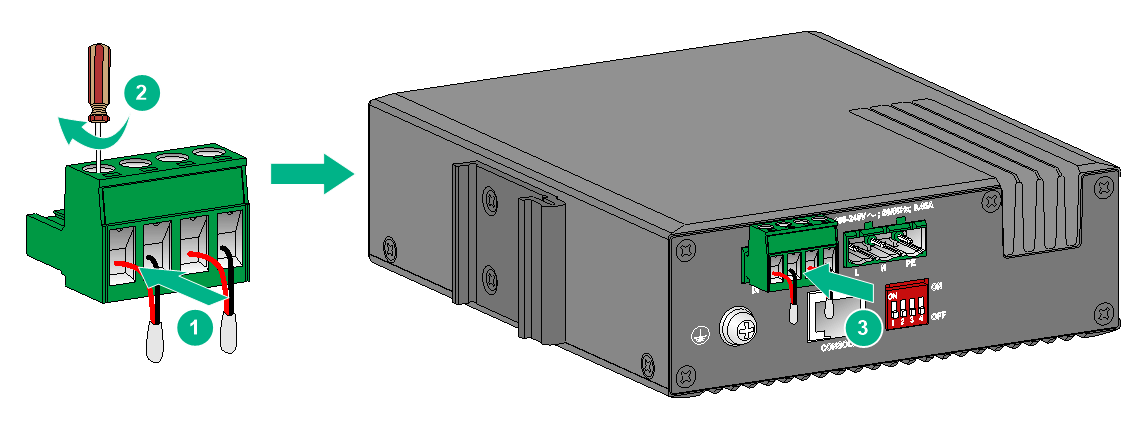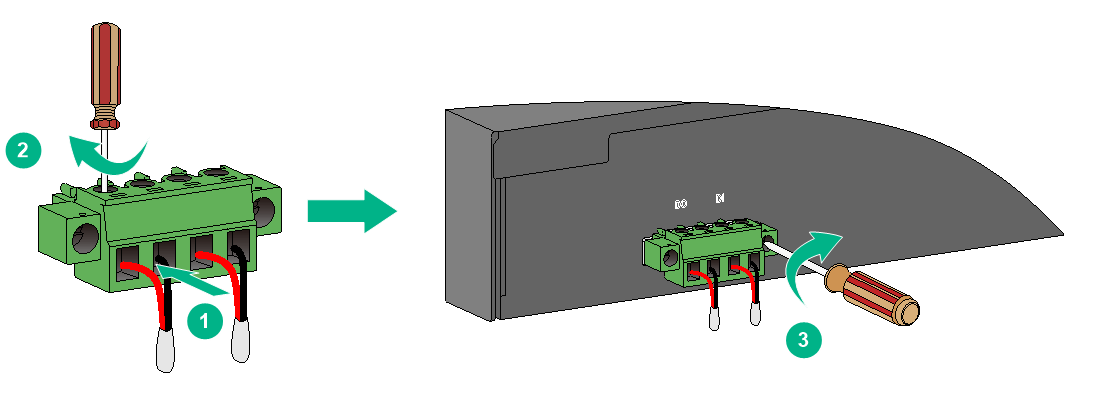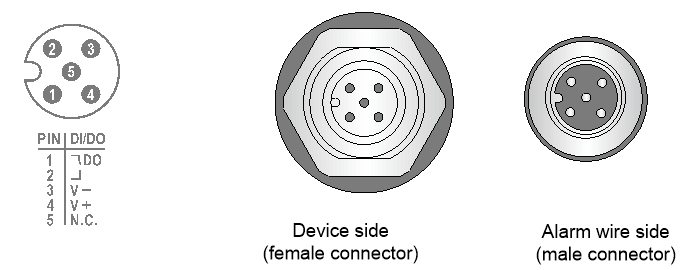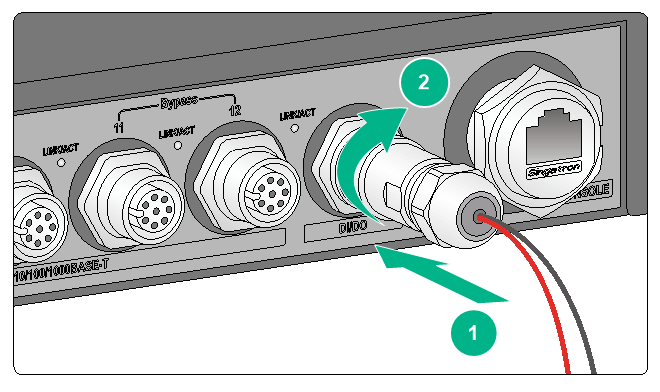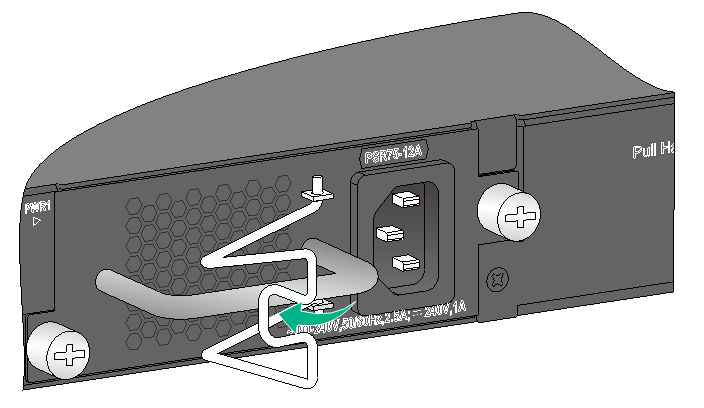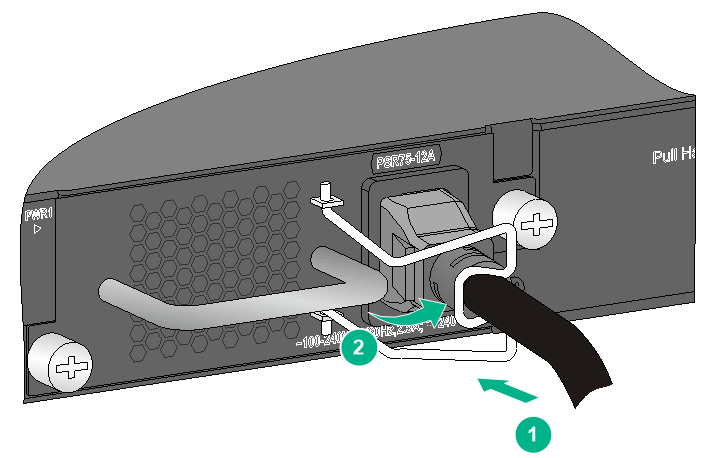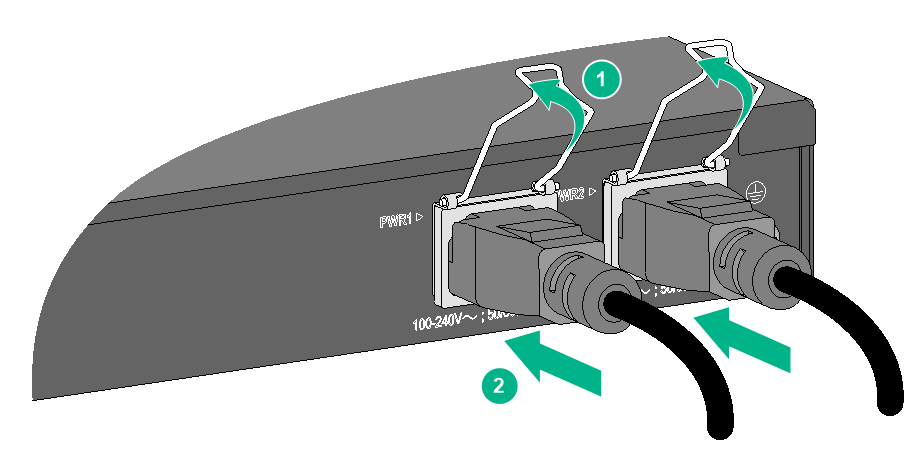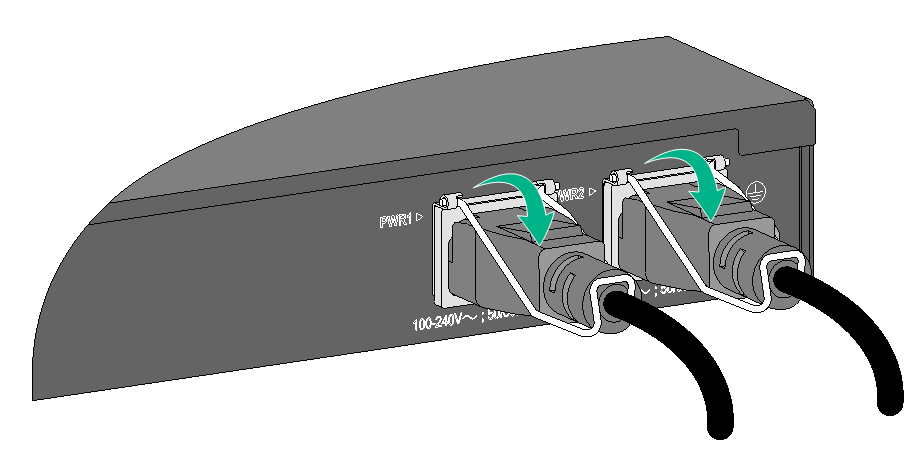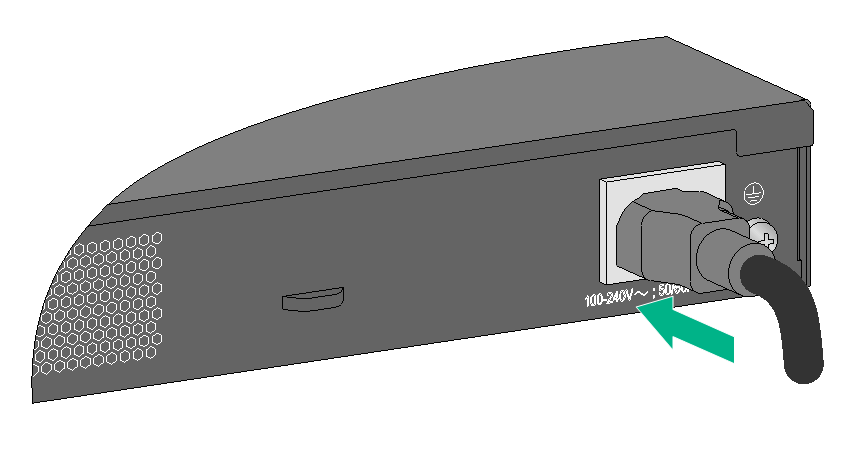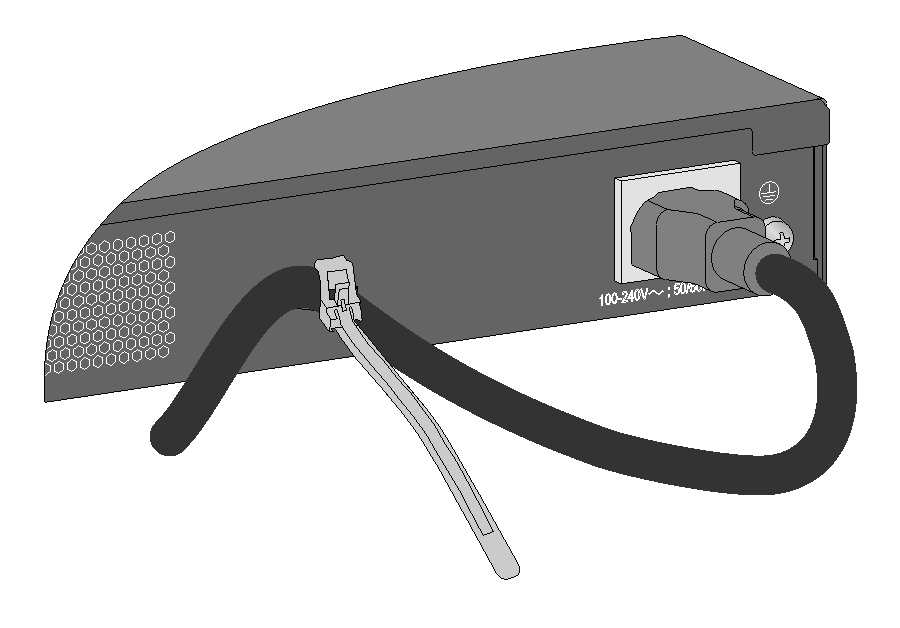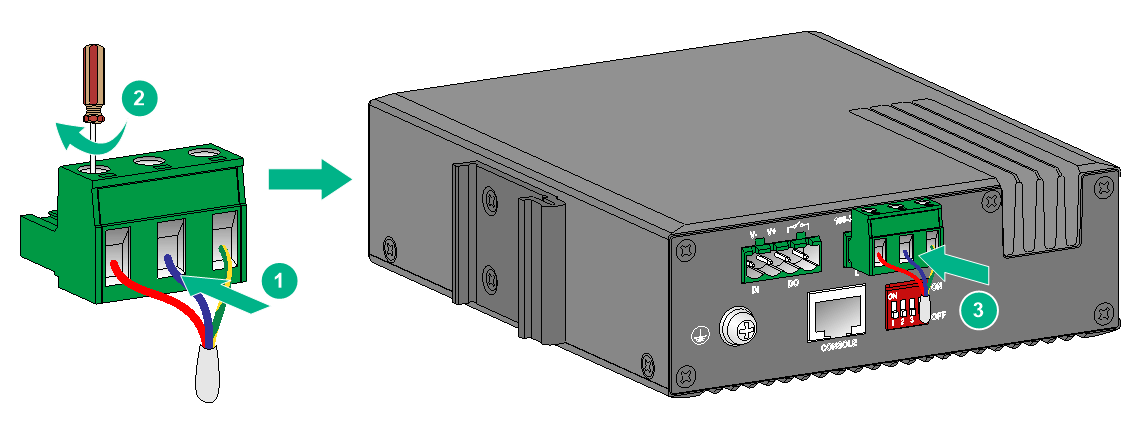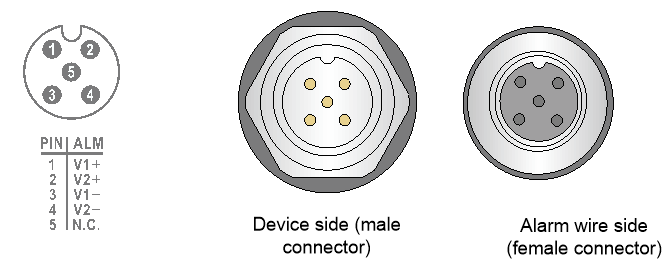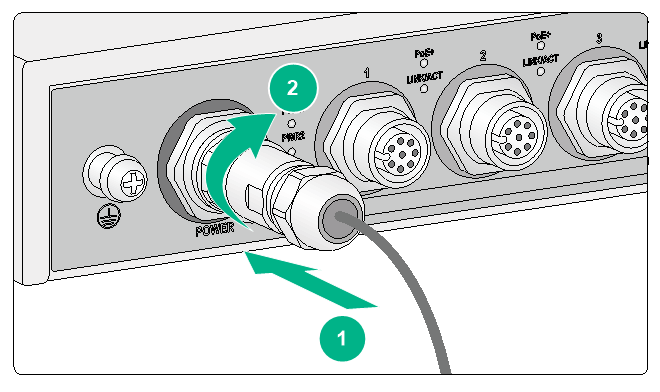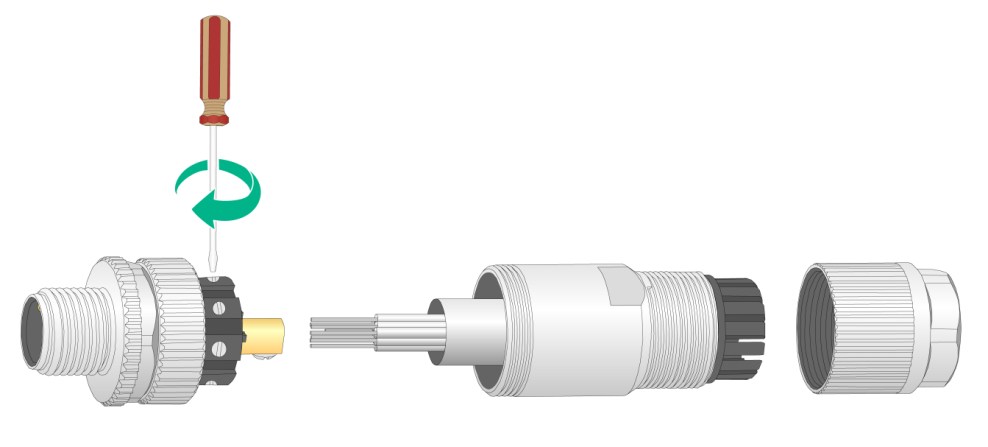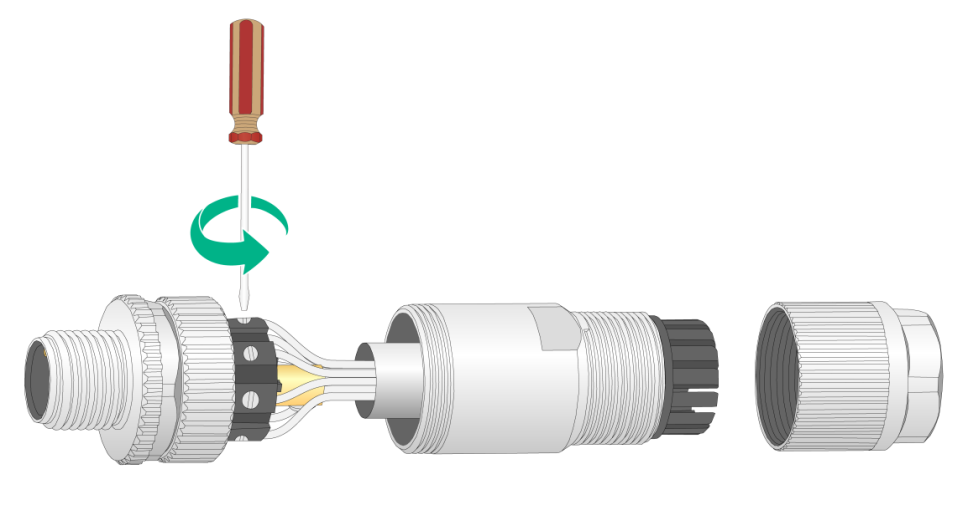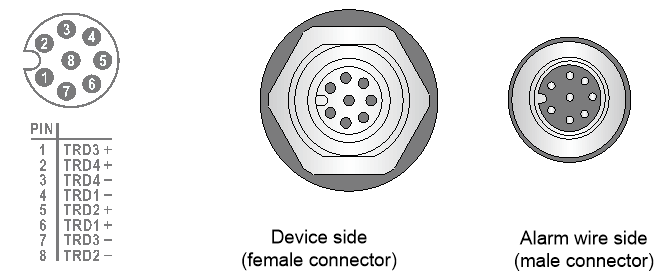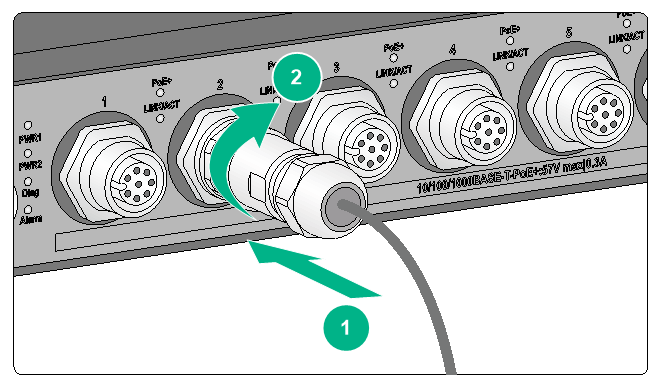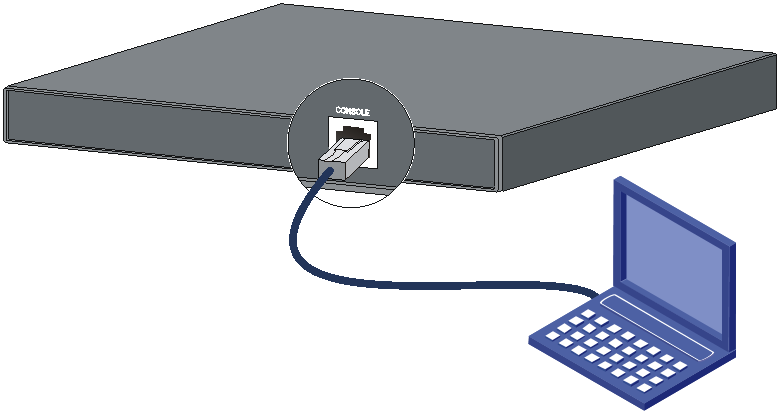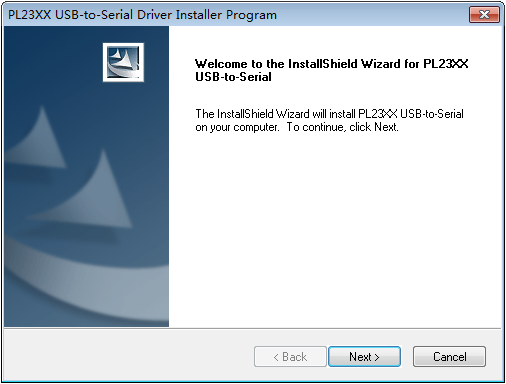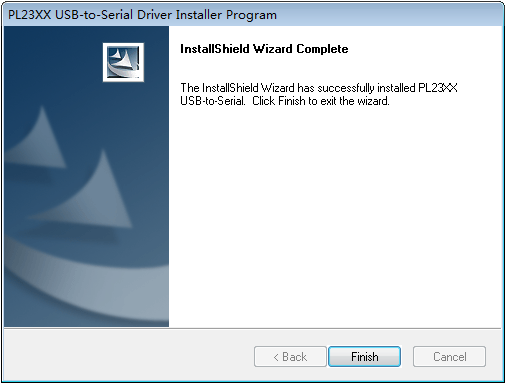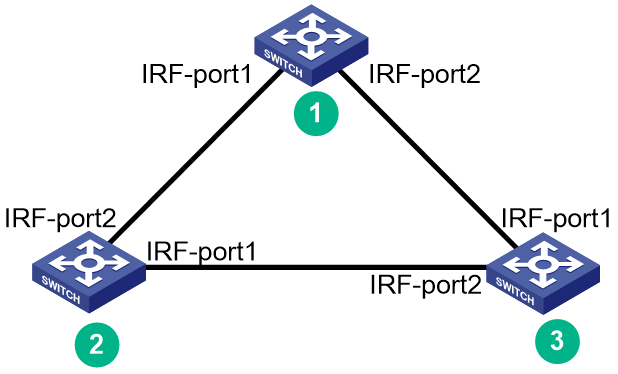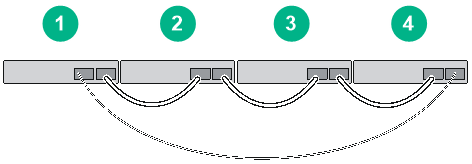- Table of Contents
- Related Documents
-
| Title | Size | Download |
|---|---|---|
| 01-Text | 3.26 MB |
Contents
Examining the installation site
Examining the installation site
Checking power distribution or power supply environment
Installing the switch in a 19-inch rack
Attaching the front mounting brackets to the switch
Mounting the switch on a workbench
Mounting the switch on a DIN rail
Mounting the switch on a DIN rail
Connecting the grounding cable
Grounding the switch by using a grounding strip
Grounding the switch by using a grounding conductor buried in the earth ground
Verifying the connection after grounding the switch
Installing and removing a power supply
Connecting the power cord for a PSR75-12A power supply
Connecting the AC power cord for a fixed AC power supply (secured by a bail latch)
Connecting the AC power cord for a fixed AC power supply (secured by a cable tie)
Connecting the AC power cord for a fixed AC power supply (through a terminal block)
Connecting the DC power cord for a fixed DC power supply (through a terminal block)
Connecting the DC power cord for a fixed DC power supply (through an M16 connector)
Connecting Ethernet cables for an IE4320-12P-PWR-M or IE4320-12P-PWR-M-NAT switch
Terminating an Ethernet cable with an M12 connector
Connecting an Ethernet cable to the device
Accessing the switch for the first time
Connecting the switch to a configuration terminal
Connecting a DB9-to-RJ45 console cable
Connecting a USB-to-RJ45 console cable
Configuring basic IRF settings
Connecting the IRF physical ports
Verifying the IRF fabric status
Maintenance and troubleshooting
Removable power supply failure
Configuration terminal display issues
No display on the configuration terminal
Garbled display on the configuration terminal
Preparing for installation
This document is applicable to the IE4320 industrial switch series. Table 1 describes the IE4320 industrial switch models.
Table 1 IE4320 industrial switch models
|
Subseries |
Switch model |
|
IE4320S rack mounting industrial switch series |
IE4320S-26S |
|
IE4320S-50S |
|
|
IE4320 DIN-rail mounting industrial switch series |
IE4320-6P |
|
IE4320-6P-AC |
|
|
IE4320-12P |
|
|
IE4320-12P-UPWR |
|
|
IE4320-20P |
|
|
IE4320 TSN DIN-rail mounting industrial switch series |
IE4320-10S |
|
IE4320-10S-UPWR |
|
|
IE4320 rack mounting industrial switch series |
IE4320-28F |
|
IE4320-28P |
|
|
IE4320-28P-S |
|
|
IE4320-28S |
|
|
IE4320-28S-HPWR |
|
|
IE4320-28S-PS1 |
|
|
IE4320-52P |
|
|
IE4320-52S |
|
|
IE4320 M12 rack mounting industrial switch series |
IE4320-12P-PWR-M |
|
IE4320-12P-PWR-M-NAT |
Unless otherwise stated, power supplies and power modules are used interchangeably in this document.
If the switch is used in a manner not specified by the manufacturer, the protection provided by the switch might be impaired.
The IE4320-28P switch model includes switches with the LS-IE4320-28P and LS-IE4320-28P-K product codes. Information described for the IE4320-28P switch model applies to the switches with the LS-IE4320-28P or LS-IE4320-28P-K product code.
Safety recommendations
To avoid bodily injury or damage to the switch, read the following safety recommendations carefully before working with the switch. Note that the recommendations do not cover every possible hazardous condition.
· Before cleaning the switch, remove all power cords from the switch. Do not clean the switch with wet cloth or liquid.
· Do not place the switch near water or in a damp environment. Prevent water or moisture from entering the switch chassis.
· Do not place the switch on an unstable case or desk.
· Ensure adequate ventilation for the switch and keep the protective vents of the switch unblocked.
· Make sure the power source voltage meets the requirements of the switch.
· To avoid electrical shocks, do not open the chassis while the switch is operating. As a best practice, do not open the chassis even if the switch is powered off.
· To avoid ESD damage, always wear an ESD wrist strap when you replace a power supply.
Examining the installation site
Install the switch in a control cabinet or in an enclosed area.
To ensure correct operation of your switch, make sure the installation environment meets the requirements listed in Table 2.
Table 2 Checking list for the installation environment
|
Item |
Requirements |
|
Ventilation and heat dissipation |
To ensure correct operation of your device, make sure the installation environment is adequately ventilated to prevent the switch from overheating. · Ensure a minimum clearance of 10 cm (3.94 in) around the chassis. · Do not install the device near a heat source, for example, a stove or heater. · Ensure air ventilation in the installation environment. · Do not block the ventilation holes in the device or power adapter. |
|
Anti-moisture |
Water or moisture might damage the circuits of the device. · Do not place the device near water or in a damp environment. · Install the switch in a clean, dry, and ventilated place where temperature is controlled in a stable range. · Make sure the installation environment is free from water leakage or condensation. If required, install a dehumidification device (such as an air conditioner with a dehumidification function or a dedicated dehumidifier). · Do not operate the device under or near the water source, such as the wash basin, laundry room, or areas with high humidity. · Do not touch the device with wet hands. |
|
Lightning protection |
Ground the switch correctly and verify the grounding. For more information, see "Connecting the grounding cable." · If you ground the switch by using a grounding strip, make sure the grounding resistance of the grounding strip in the equipment room is less than 1W. · If you ground the switch by using a grounding conductor buried in the earth ground, make sure the grounding resistance of the grounding conductor in the ground is less than 10W. · Route the signal cables along indoor walls, bury the cables in the earth ground, or thread the cables through steel tubes. Install a signal lightning arrester with a nominal discharge current for a corresponding network interface. · Keep the signal cables far from power cords and lightning rod down conductors. · As a best practice, route power cords indoors. If an AC power cord is routed from outdoors, connect the AC power cord first to a power lightning arrester before leading it to the AC power port on the switch. Make sure the power lightning arrester has a nominal discharge current and the total length of the power cord from the power lighting arrester to the power port on the switch is less than 5 m (16.40 ft). · Ground the switch, rack, independent power supplies, and lightning arresters separately. · You must ground optical fibers with reinforcing metal stiffener from outdoors on an optical distribution frame (ODF) or fiber splice enclosure. |
|
Cable routing |
Do not run an Ethernet cable and power cord in parallel. · Route different types of cables separately. · Keep power cords a minimum of 5 cm (1.97 in) away from other cables. |
|
Mechanical environment |
The IE4320-12P-PWR-M and IE4320-12P-PWR-M-NAT switches are railroad car-mounted devices. The environment where they are installed must meet the Category 1 Class B mechanical environment requirements (which is referenced by EN 50155) defined in EN 61373. As a best practice, if you install an IE4320 switch (except the IE4320-12P-PWR-M or IE4320-12P-PWR-M-NAT) outdoors, make sure the mechanical environment is not harsher than the 4M4 class. NOTE: 4M represents the mechanical environment condition defined by GB/T 4798.4. It has eight classes. The 4M4 class refers to places impacted by machines, running vehicles, ground blasting or piling. |
|
Dust and water resistance |
If you install the switch in an outdoor environment, make sure the installation and operating environments meet the requirements of IP55 rating protection. NOTE: IP indicates International Protection Rating. The first number "5" refers to the rating for preventing the solid particle from entering the cabinet. An outdoor cabinet cannot prevent dust intrusion perfectly, but the dust cannot damage the device. The second number "5" refers to the rating for preventing water from entering the cabinet. Water projected in jets against the enclosure from any direction cannot damage the device. |
|
ESD prevention |
· Ground the switch correctly. · To avoid ESD damage to the device or components, always wear an ESD wrist strap when you install or remove the device or components. · Make sure the wrist strap has good skin contact and is reliably grounded. |
|
Corrosive gas prevention |
The installation site must be free from corrosive gases such as acid gases and alkaline gases. |
|
EMI |
· If AC power is used, use a single-phase three-wire power receptacle with protection earth (PE) to filter interference from the power grid. · Keep the device far away from radio transmitting stations, radar stations, and high-frequency devices. · Use electromagnetic shielding, for example, shielded interface cables, when necessary. |
Examining the installation site
Before you install the switch, verify that the installation site meets the installation requirements. The switch can operate correctly in an A1, A2, or A3 installation site. Availability issues might occur if you install the switch in a B1, B2, or C installation site.
|
Category |
Definition |
Example |
|
A1: indoor controlled environment |
· Indoor environments where temperature and humidity are controlled. · Completely enclosed or shielded indoor environments. |
Central equipment rooms, IDC equipment rooms, mobile cabins with air conditioners, outdoor air conditioner cabinets, and heat exchanger cabinets. |
|
A2: indoor partially controlled environment |
· Indoor environments where temperature and humidity are partially controlled. · Incompletely enclosed or shielded places. · Places far from pollution sources. |
Simple equipment rooms, ordinary houses, garages, corridors, and direct ventilation cabinets far from pollution sources, houses without direct exposure to sunlight or rain, railway station platforms, and stadiums. |
|
A3: indoor uncontrolled environment |
· Indoor environments where temperature and humidity are uncontrolled. · Incompletely enclosed or shielded places. · Places near pollution sources. |
Simple equipment rooms, ordinary houses, garages, corridors, and direct ventilation cabinets near pollution sources, houses without direct exposure to sunlight or rain, railway station platforms, stadiums, uncleaned rooms after decoration, and rooms under decoration. |
|
B1: outdoor general environment |
· Unshielded places where the temperature and humidity are not controlled. · Places far from pollution sources. |
Completely exposed outdoor places far from pollution sources. |
|
B2: harsh environment |
· Unshielded places where the temperature and humidity are not controlled. · Sea environments or outdoor land environments near pollution sources. |
Islands, ships, and completely exposed outdoor places near pollution sources. |
|
C: special environments |
Special application environments |
Buried, underwater, or undersea environments and manholes. |
Table 4 Pollution sources
|
Category |
Radius range |
|
Saline water areas such as oceans and saline lakes |
≤ 3.7 km (2.30 miles) |
|
Serious pollution sources such as metallurgic plants, coal mines, and heat and power plants |
≤ 3 km (1.86 miles) |
|
Medium pollution sources such as chemical factories, rubber plants, and electroplating factories |
≤ 2 km (1.24 miles) |
|
Light pollution sources, such as food factories, tanneries, and heating boilers |
≤ 1 km (0.62 miles) |
Checking power distribution or power supply environment
Table 5 Requirements for power distribution or power supply environment
|
Item |
Requirements |
|
Preparation |
The power supply must be available before you install the switch. |
|
Voltage |
The voltage provided to the switch must be within the operating voltage range. For the operating voltage range, see IE4320 Industrial Switches Hardware Information and Specifications. |
|
Power receptacle and cables |
· If the external power supply system provides an AC power outlet, use a country-specific AC power cord. Make sure the PE wire of the AC power supply is grounded reliably. · If the external power supply system provides a DC distribution box, prepare DC power cords yourself. · The switch came with a terminal block connected to each power receptacle. No power cord is provided with the switch. Prepare compatible copper power wires yourself as required. For information about the wire diameter and connection requirements, see "Connecting power cords." |
Laser safety
|
WARNING! The switch is a Class 1 laser device. Please use Class 1 laser transceiver modules certified by UL or CDRH. Disconnected optical fibers or transceiver modules might emit invisible laser light. Do not stare into beams or view directly with optical instruments when the switch is operating. |
Installation tools
No installation tools are provided with the switch. Prepare the following tools yourself as required:
· Flat-head screwdriver
· Phillips screwdriver
· ESD wrist strap
· Needle-nose pliers
· Diagonal pliers
· Crimping tool
· Adjustable wrench (applicable to IE4320-12P-PWR-M or IE4320-12P-PWR-M-NAT switch installation)
Installing the switch
|
CAUTION: Keep the tamper-proof seal on a mounting screw on the chassis cover intact, and if you want to open the chassis, contact H3C for permission. Otherwise, H3C shall not be liable for any consequence. |
Installation flowchart
Figure 1 Installation flowchart
Table 6 Installation positions
|
Subseries |
Switch model |
Applicable installation positions |
Installation procedure |
|
IE4320S rack mounting industrial switches |
IE4320S-26S IE4320S-50S |
Mount the switch in a 19-inch rack or on a work bench |
See "Installing the switch in a 19-inch rack" and "Mounting the switch on a workbench." |
|
IE4320 rack mounting industrial switches |
IE4320-28F IE4320-28P IE4320-28P-S IE4320-28S IE4320-28S-HPWR IE4320-28S-PS1 IE4320-52P IE4320-52S |
Mount the switch in a 19-inch rack or on a work bench |
See "Installing the switch in a 19-inch rack" and "Mounting the switch on a workbench." |
|
IE4320 M12 rack mounting industrial switches |
IE4320-12P-PWR-M IE4320-12P-PWR-M-NAT |
Mount the switch on a DIN rail |
See "Installing the switch in a 19-inch rack" and "Mounting the switch on a workbench." |
|
IE4320 DIN-rail mounting industrial switches |
IE4320-6P IE4320-6P-AC IE4320-12P IE4320-12P-UPWR IE4320-20P |
Mount the switch on a DIN rail |
|
|
IE4320 TSN DIN-rail mounting industrial switches |
IE4320-10S IE4320-10S-UPWR |
Mount the switch on a DIN rail |
Installing the switch in a 19-inch rack
Figure 2 Procedure for installing the switch in a 19-inch rack by using front mounting brackets
|
|
NOTE: If a rack shelf is available, you can put the switch on the rack shelf, slide the switch to an appropriate location, and attach the switch to the rack by using the mounting brackets. |
Mounting brackets
Figure 3 Front mounting bracket
|
(1) Screw hole for attaching the bracket to the switch |
|
(2) Screw hole for attaching the bracket to the front rack post |
Attaching the front mounting brackets to the switch
You can install the front mounting brackets only at the port side of the switch.
To attach the front mounting brackets to the chassis:
1. Place the wide flange of the mounting bracket against the chassis side panel. Align the mounting bracket installation holes with the screw holes in the chassis.
2. Fasten the M4 screws to secure the mounting bracket to the switch.
3. Attach the front mounting bracket to the other side of the chassis in the same way.
Figure 4 Attaching the front mounting brackets to the port-side mounting position
Rack-mounting the switch
This task requires two people.
To rack-mount the switch:
1. Wear an ESD wrist strap and make sure it makes good skin contact and is reliably grounded.
2. Determine the switch installation position on the rack. Install two cage nuts (user supplied) at a distance of 1 U between them on each rack post. Make sure the corresponding cage nuts on the left and right rack posts are at the same height.
3. Verify that the front mounting brackets have been securely attached to the switch chassis. See "Attaching the front mounting brackets to the switch."
4. Attach cage nuts to the front rack posts.
5. One person supports the bottom of the switch, and aligns the installation holes on the mounting brackets with the cage nuts on the rack posts.
6. Another person uses four user supplied M6 screws to attach the mounting brackets to the rack and verifies that the brackets are level and secure.
Figure 5 Rack-mounting the switch in a rack
Mounting the switch on a workbench
|
IMPORTANT: · Reserve a minimum clearance of 10 cm (3.94 in) around the chassis for heat dissipation. · Do not place heavy objects on the switch. |
To mount the switch on a workbench:
1. Verify that the workbench is sturdy and reliably grounded.
2. Place the switch with bottom up, and clean the round holes in the chassis bottom with dry cloth.
3. Attach the rubber feet to the four round holes in the chassis bottom.
4. Place the switch with upside up on the workbench.
Mounting the switch on a DIN rail
As a best practice, place the switch in an environment with the mechanical class not above 4M4. Use a cabinet with an IP rating of IPX1 or higher for installing the switch.
DIN bracket and DIN rail
The switch comes with a DIN bracket installed on it.
Figure 6 DIN bracket
|
(1) Metal spring |
(2) Screw hole |
Table 7 shows the dimensions of the DIN rails applicable to the DIN bracket. Prepare the DIN rails as required.
Table 7 Applicable DIN rail dimensions
|
Switch model |
DIN rail dimensions (H × W × D) |
|
IE4320-6P IE4320-6P-AC IE4320-12P IE4320-12P-UPWR IE4320-10S IE4320-10S-UPWR |
7.5 × 35 × 1 mm (0.30 × 1.38 × 0.04 in) |
|
IE4320-20P |
15 × 35 × 1 mm (0.59 × 1.38 × 0.04 in) |
Figure 7 DIN rail
Mounting the switch on a DIN rail
1. Wear an ESD wrist strap and make sure it makes good skin contact and is reliably grounded.
2. As shown by callout 1 in Figure 8, position the switch so that the spring of the DIN bracket compresses against the upper edge of the DIN rail.
3. As shown by callout 2 in Figure 8, rotate the switch down toward the DIN rail until the DIN bracket clicks.
Figure 8 Installing the switch on a DIN rail (IE4320-12P-UPWR)
Connecting the grounding cable
|
WARNING! · Correctly connecting the grounding cable is crucial to lightning protection and ESD and EMI protection. You must connect the grounding cable correctly and reliably for the switch. · Do not connect the positive pole or negative pole of a DC power receptacle to the ground. To ground the switch, use the grounding cable and grounding screws. · Connect the grounding cable to the grounding strip in the equipment room. Do not connect it to a fire main or lightning rod. |
To protect against the following types of issues, use a grounding cable to connect the switch to the earthing facility at the installation site:
· Bodily injury from electric shocks.
· Device and power and data line damages.
· Electrical fires, lightning strokes, electromagnetic coupling interferences, and ESD damages.
Select a grounding method based on the installation environment.
|
|
NOTE: The power and grounding terminals in this section are for illustration only. |
Grounding the switch by using a grounding strip
If a grounding strip is available at the installation site, use the grounding cable provided with the switch to connect the switch to the grounding strip.
Connecting the grounding cable to the chassis
1. Remove the grounding screw from the grounding hole in the chassis.
2. Use the grounding screw to attach the ring terminal of the grounding cable to the grounding screw hole, and then fasten the screw.
Figure 9 Connecting the grounding cable to the chassis (IE4320S-50S)
|
(1) Grounding screw |
(2) Ring terminal |
|
(3) Grounding sign |
(4) Grounding hole |
|
(5) Grounding cable |
|
Connecting the grounding cable to a grounding strip
1. Cut the grounding cable to a length according to the distance between the switch and the grounding strip.
2. Peel 20 mm (0.79 in) of insulation sheath by using a wire stripper.
3. Use needle-nose pliers to bend the bare metal part to the shape as shown in Figure 10. Make sure the bended part can be securely attached to the grounding post on the grounding strip.
4. Attach the bended part of the grounding cable to the grounding post and use the hex nut to fasten the bended part to the post.
Figure 10 Connecting the grounding cable to a grounding strip
|
(1) Grounding post |
(2) Grounding strip |
|
(3) Grounding cable |
(4) Hex nut |
Grounding the switch by using a grounding conductor buried in the earth ground
If the installation site does not have grounding strips, but earth ground is available, hammer a 2.5 m (8.20 ft) or longer angle iron or steel tube into the earth ground to act as a grounding conductor. Make sure a minimum of 0.7 m (2.30 ft) is left between the top of the grounding conductor and the ground. In cold areas, bury the grounding conductor below the frozen soil layer. In areas with thin soil or rocky gravel, determine the depth for burying the grounding conductor based on the actual condition.
If zinc-coated steel is used, the following dimensions requirements must be met:
· Angle iron—A minimum of 50 × 50 × 5 mm (1.97 × 1.97 × 0.20 in).
· Steel tube—A minimum of 3.5 mm (0.14 in) in thickness.
· Flat steel—A minimum of 40 × 4 mm (1.57 × 0.16 in).
· Round steel—A minimum of 10 mm (0.39 in).
Weld the yellow-green grounding cable to the angel iron or steel tube and treat the joint for corrosion protection.
Figure 11 Grounding the switch by burying the grounding conductor into the earth ground (IE4320S-50S)
|
(1) Grounding screw |
(2) Chassis rear panel |
(3) Grounding cable |
|
(4) Earth |
(5) Welding point |
(6) Grounding conductor |
Verifying the connection after grounding the switch
· If you ground the switch by using a grounding strip:
a. Use a multimeter to measure the resistance between the switch grounding terminal and grounding point, and make sure the resistance is less than 0.1W.
b. Use a grounding resistance tester to measure the grounding resistance of the grounding strip, and make sure the grounding resistance is less than 1W.
· If you ground the switch by using a grounding conductor buried in the earth ground:
a. Use a multimeter to measure the resistance between the switch grounding terminal and grounding point, and make sure the resistance is less than 0.1W.
b. Use a grounding resistance tester to measure the grounding resistance of the angle iron in the ground, and make sure the grounding resistance is less than 10W. For locations with high soil resistivity, sprinkle some resistance reducer to reduce soil resistivity or replace soil around the grounding strip with soil with lower resistance.
For information about resistance measurement, see H3C Network Devices Lightning Protection Guide.
Installing and removing a power supply
|
WARNING! In power redundancy mode, you can replace a power supply without powering off the switch but you must strictly follow the installation and removal procedures in Figure 12 and Figure 13 to avoid any bodily injury or damage to the switch. |
|
CAUTION: Provide a circuit breaker for each power supply. |
This section is applicable only to the switch models that use removable power supplies.
The IE4320S-26S and IE4320S-50S switches each provide two power supply slots. They each come with power supply slot PWR1 empty and power supply slot PWR2 installed with a filler panel. You can install one power supply, or two power supplies for redundancy. For the power supplies available for the switch and their specifications, see IE4320 Industrial Switch Series Hardware Information and Specifications.
Figure 12 Installation procedure
Installing a power supply
|
CAUTION: To prevent damage to the power supply or the connectors on the backplane, insert the power supply gently. If you encounter a hard resistance when inserting the power supply, pull out the power supply and insert it again. |
To install a power supply:
1. Wear an ESD wrist strap and make sure it makes good skin contact and is reliably grounded.
2. Remove the filler panel from the target power supply slot as follows:
a. Use a Phillips screwdriver to loosen the screws on the filler panel.
b. Remove the filler panel.
Figure 14 Removing the filler panel
3. Unpack the power supply and verify that the power supply model is correct.
4. Correctly orient the power supply with the power supply slot (use the letters on the power supply faceplate for orientation). Grasping the handle of the power supply with one hand and supporting its bottom with the other, slide the power supply slowly along the guide rails into the slot (see callout 1 in Figure 15).
5. Fasten the screws on the power supply with a Phillips screwdriver to secure the power supply in the chassis (see callout 2 in Figure 15). If the screws cannot be tightly fastened, verify the installation of the power supply.
Figure 15 Installing a power supply
Removing a power supply
1. Wear an ESD wrist strap and make sure it makes good skin contact and is reliably grounded.
2. Disconnect the power cord from the power source.
3. Loosen the screws on the power supply with a Phillips screwdriver until they are completely disengaged.
4. Grasp the handle of the power supply with one hand and pull it out a little, support the bottom with the other hand, and pull the power supply slowly along the guide rails out of the slot.
Put away the removed power supply in an antistatic bag or the power supply package bag for future use.
5. Install a filler panel to prevent dust and ensure good ventilation if no power supply is installed in the slot.
Wiring external alarms
|
CAUTION: Before you wire external alarms, make sure the switch is reliably grounded and is powered off. |
No alarm input and alarm output wires are provided with the switch. Prepare compatible copper wires yourself as required. Table 8 shows the specifications for alarm input and output wires.
Table 8 Alarm input and output wire specifications
|
Switch model |
Minimum conductor cross-sectional area |
Maximum conductor cross-sectional area |
External alarm wiring procedure |
|
IE4320-6P-AC IE4320-6P IE4320-10S IE4320-10S-UPWR IE4320-12P IE4320-12P-UPWR IE4320-20P IE4320S-26S IE4320S-50S IE4320-28F IE4320-28P IE4320-28P-S IE4320-28S IE4320-28S-HPWR IE4320-28S-PS1 IE4320-52P IE4320-52S |
0.08 mm² or 28 AWG |
0.5 mm² or 20 AWG |
|
|
IE4320-12P-PWR-M IE4320-12P-PWR-M-NAT |
0.2 mm² or 24 AWG |
0.5 mm² or 20 AWG |
The alarm output connection (DO) outputs alarms by closing or opening the relay contact. It has a current carrying capacity of 1 A/24 VDC and does not support power supply to the connected device. Connect the alarm output connection to a conventional resistive load.
For information about the alarm input/output connection, see device management configuration in Fundamentals Configuration Guide in the set of configuration guides for the switch.
Wiring external alarms by using an alarm connector
|
CAUTION: To avoid connection mistakes, identify the positive (+) and negative (-) marks above the alarm connector. |
The switch comes with the alarm connector installed on it. The alarm connector is used for connecting alarm signals to the switch. Before connecting wires to the alarm connector, remove the alarm connector.
To wire external alarms by using an alarm connector:
1. Choose the alarm input and output wires depending on the installation site requirements.
2. Use a wire stripper to strip the heat-shrink tubes off the input and output wires on one end, and then strip the electrical insulation off the positive (red) and negative (black) wires to make sure about 7 mm (0.28 in) of the wire reaches out.
Repeat this step for the other end.
3. Use a flat-head screwdriver to loosen the screws on the alarm connector and then remove the alarm connector.
4. Position the alarm connector upside up. Insert the alarm input and output wires into the alarm connector as shown by callout 1 in Figure 16 or callout 1 in Figure 17.
If you orient the alarm connector upside down, you cannot install it on the switch.
5. Use a flat-head screwdriver to fasten the screws at the bottom of the alarm connector to secure the wires to the connector, as shown by callout 2 in Figure 16 or callout 2 in Figure 17.
6. Attach the alarm connector to the switch.
¡ IE4320-6P-AC—Insert the alarm connector into the switch directly, as shown by callout 3 in Figure 16.
¡ Other switch models—Use a flat-head screwdriver to fasten the screws on the alarm connector to secure the connector to the switch, as shown by callout 3 in Figure 17.
7. Connect the other ends of the input and output wires to an external device.
Figure 16 Wiring external alarms by using an alarm connector (IE4320-6P-AC)
Figure 17 Wiring external alarms by using an alarm connector (IE4320-28P)
|
|
NOTE: The wire colors in the preceding figures are for illustration only. |
Wiring external alarms by using an M12 connector
1. Orient the alarm wire connector with the alarm input/output connection on the switch.
Figure 18 Alarm wire connector and alarm input/output connection sections
2. Insert the alarm wire connector into the alarm input/output connection slowly, as shown by callout 1 in Figure 19.
If you cannot insert the alarm wire connector into the switch, re-orient the alarm wire connector rather than use excessive force to push it in.
3. Use a wrench to fasten the alarm wire connector, as shown by callout 2 in Figure 19.
4. Connect the other ends of the input and output wires to an external device.
Figure 19 Wiring external alarms through an M12 connector
Connecting power cords
Table 9 Power cord connection procedures at a glance
|
Switch model |
Available power source |
Connection procedure |
Remarks |
|
IE4320S-26S IE4320S-50S |
AC power source |
N/A |
|
|
240V HVDC power source |
|||
|
IE4320-28F IE4320-28P IE4320-28P-S IE4320-28S IE4320-52P IE4320-52S |
AC power source |
Connecting the AC power cord for a fixed AC power supply (secured by a bail latch) |
The switch provides two fixed AC power receptacles on the rear panel. One AC power receptacle can meet the power requirement of the switch. You can use both of the AC power receptacles for redundancy. |
|
IE4320-6P-AC |
AC power source |
Connecting the AC power cord for a fixed AC power supply (through a terminal block) |
N/A |
|
IE4320-6P IE4320-10S IE4320-12P IE4320-20P |
24 V to 48 V DC power source |
Connecting the DC power cord for a fixed DC power supply (through a terminal block) |
The switch supports dual DC power feeds for redundancy. |
|
IE4320-10S-UPWR IE4320-12P-UPWR IE4320-28S-HPWR |
53 V to 57 V DC power source |
Connecting the DC power cord for a fixed DC power supply (through a terminal block) |
The switch supports dual DC power feeds. You can use two H3C DG-240-55XX industrial power supplies connected in parallel to achieve load sharing for high power requirements. |
|
IE4320-28S-PS1 |
AC power source |
Connecting the AC power cord for a fixed AC power supply (secured by a cable tie) |
The switch supports concurrent AC and DC power supply for redundancy. |
|
24V to 48 V DC power source |
Connecting the DC power cord for a fixed DC power supply (through a terminal block) |
The switch supports concurrent AC and DC power supply for redundancy. |
|
|
IE4320-12P-PWR-M IE4320-12P-PWR-M-NAT |
66 V to 160 V HVDC power source |
Connecting the DC power cord for a fixed DC power supply (through an M16 connector) |
N/A |
No power cord is provided with the switch that uses a DC power source, excluding the IE4320-12P-PWR-M and IE4320-12P-PWR-M-NAT. Prepare compatible copper cables yourself as required. Table 10 shows the specifications of copper cables.
Table 10 Copper cable specifications
|
Switch model |
Minimum conductor cross-sectional area |
Maximum conductor cross-sectional area |
|
IE4320-6P IE4320-10S IE4320-12P IE4320-20P IE4320-10S-UPWR IE4320-12P-UPWR IE4320-28S-HPWR IE4300-12P-PWR IE4320-28S-PS1 |
0.5 mm² or 20 AWG |
3 mm² or 12 AWG |
Connecting the power cord for a PSR75-12A power supply
|
CAUTION: · Use the power cord provided with the switch. · Make sure each power cord has a separate circuit breaker. Turn off the circuit breaker before connecting the power cord. |
To connect the power cord for a PSR75-12A power supply:
1. Wear an ESD wrist strap and make sure it makes good skin contact and is reliably grounded.
2. Attach the power cord bail latch into the two holes next to the power receptacle on the power supply, and then pull the bail latch leftwards.
Figure 20 Pulling the bail latch leftwards
3. As shown by callout 1 in Figure 21, connect the plug of the power cord supplied with the power supply to the power receptacle.
4. As shown by callout 2 in Figure 21, pull the bail latch rightwards to secure the plug to the power receptacle.
5. Connect the other end of the power cord to an external power source. The PSR75-12A power supply supports AC power source and 240 V HVDC power source.
Figure 21 Connecting the power cord for a PSR75-12A power supply
Connecting the AC power cord for a fixed AC power supply (secured by a bail latch)
1. Wear an ESD wrist strap and make sure it makes good skin contact and is reliably grounded.
2. Attach the power cord bail latch into the two holes next to the power receptacle. Pull the bail latch upwards, as shown by callout 1 in Figure 22.
3. As shown by callout 2 in Figure 22, connect the plug of the power cord to the AC power receptacle.
Figure 22 Connecting the AC power cord for the fixed AC power supply (IE4320-28S)
4. Pivot down the bail latch to secure the plug to the power receptacle.
Figure 23 Securing the plug to the power receptacle (IE4320-28S)
Connecting the AC power cord for a fixed AC power supply (secured by a cable tie)
1. Connect the plug of the AC power cord to the AC power receptacle on the switch.
Figure 24 Connecting the AC power cord for the fixed AC power supply (IE4320-28S-PS1)
2. Use a cable tie to secure the power cord to the handle near the AC power receptacle.
Figure 25 Securing the AC power cord to the handle (IE4320-28S-PS1)
3. Connect the other end of the power cord to an AC power source.
Connecting the AC power cord for a fixed AC power supply (through a terminal block)
|
WARNING! · Make sure each power cord has a separate circuit breaker. · Turn off the circuit breaker before connecting the power cord. · To avoid connection mistakes, identify the positive (+) and negative (-) marks above the AC power receptacle for the terminal block connection. · The IE4320-6P-AC switch uses a terminal block for AC power cord connection. Do not hot swap the terminal block. |
The IE4320-6P-AC switch comes with a terminal block installed on it.
To connect an AC power cord for an IE4320-6P-AC switch:
1. Verify that the switch is disconnected from the power source.
2. Use a wire stripper to strip the heat-shrink tubes off the three-wire power cord on one end, and then strip the electrical insulation off to make sure about 7 mm (0.28 in) of the wire reaches out.
The live wire is in red, neutral wire is in blue, and earth wire is in yellow and green.
3. Orient the terminal block with upside up and identify the "L", "N", and "PE" connections on the terminal block.
If you orient the terminal block upside down, you cannot insert it into the power receptacle.
4. As shown by callout 1 in Figure 26, insert the AC wires into the terminal block, with the live wire, natural wire, and the PE wire inserted into the "L", "N", and "PE" connections, respectively.
5. As shown by callout 2 in Figure 26, use a flat-head screwdriver to fasten the screws on the terminal block to secure the wires to the terminal block.
6. As shown by callout 3 in Figure 26, connect the terminal block to the AC power receptacle.
7. Turn on the circuit breaker and observe the power status LED on the front panel. If the LED is on, power is being supplied to the switch correctly.
Figure 26 Connecting the AC power cord for an IE4320-6P-AC switch
|
|
NOTE: The wire colors in the preceding figure are for illustration only. |
Connecting the DC power cord for a fixed DC power supply (through a terminal block)
|
WARNING! · Make sure each power cord has a separate circuit breaker. · Turn off the circuit breaker before connecting the power cord. · To avoid connection mistakes, identify the positive (+) and negative (-) marks above the DC power receptacle for the terminal block connection and power source connection. |
As a best practice, use an H3C DG-240-55XX industrial power supply for an IE4320-10S-UPWR, IE4320-12P-UPWR, or IE4320-28S-HPWR switch. For information about the H3C DG-240-55XX industrial power supply, see H3C DG-240-55XX Industrial Power Supply Installation Quick Start.
The switch comes with a terminal block installed on it. You can use the following methods to connect the DC power cord:
· Connect the DC power cord directly to the terminal block on the DC power receptacle.
· Remove the terminal block from the switch, connect the DC power cord to the terminal block, and then secure the terminal block to the DC power receptacle.
In this section, the second method is used as an example.
To connect the DC power cord for a fixed DC power supply through a terminal block:
1. Use a wire stripper to strip the heat-shrink tubes off the positive (red) and negative (black) two-wire power cord on one end, and then strip the electrical insulation off to make sure about 7 mm (0.28 in) of the wire reaches out.
2. Remove the terminal block from the switch. Orient the terminal block with upside up and identify the positive (+) and negative (-) connections on the terminal block.
If you orient the terminal block upside down, you cannot insert it into the power receptacle.
3. As shown by callout 1 in Figure 27, insert the wires into the terminal block, with the positive wire to the positive connection and negative wire to the negative connection.
4. As shown by callout 2 in Figure 27, use a flat-head screwdriver to fasten the screws on the terminal block to secure the wires to the terminal block.
5. As shown by callout 3 in Figure 27, connect the terminal block to the DC power receptacle. Use a flat-head screwdriver to fasten the screws on the block to secure the block to the power receptacle.
6. Connect the other ends of the wires to a DC power source.
Figure 27 Connecting a DC power cord for an IE4320-28S-HPWR switch
|
|
NOTE: The wire colors in the preceding figure are for illustration only. |
Connecting the DC power cord for a fixed DC power supply (through an M16 connector)
|
WARNING! · Make sure each power cord has a separate circuit breaker. · Turn off the circuit breaker before connecting the power cord. · Identify the positive (+) and negative (-) marks on the power port to avoid connection mistakes. For the supplied power cord, connect the red wire to the positive pole of the power source and the black wire to the return pole. |
Only the IE4320-12P-PWR-M and IE4320-12P-PWR-M-NAT switches support power cords with an M16 connector.
The rated voltage and maximum voltage for the switch is 66 VDC and 160 VDC, respectively.
To connect the DC power cord for an IE4320-12P-PWR-M or IE4320-12P-PWR-M-NAT switch:
1. Orient the power cord plug with the power receptacle.
Figure 28 Power receptacle and power cord plug sections
Figure 29 Power cord
Table 11 Wire connections
|
M16 |
Wire color |
Connection to the external power supply system |
|
PIN1 |
Red |
V1+, connecting the positive pole of the external power supply system |
|
PIN2 |
White |
V2+, connecting the positive pole of the external power supply system |
|
PIN3 |
Green |
V1-, connecting the negative pole of the external power supply system |
|
PIN4 |
Black |
V2-, connecting the negative pole of the external power supply system |
2. Insert the power cord plug into the power receptacle slowly, as shown by callout 1 in Figure 30.
If you cannot insert the power cord plug into the receptacle, re-orient the power cord plug rather than use excessive force to push it in.
3. Fasten the power cord plug, as shown by callout 2 in Figure 30.
4. Connect the other end of the power cord to a power source.
Figure 30 Connecting the DC power cord for an IE4320-12P-PWR-M or IE4320-12P-PWR-M-NAT switch
Connecting Ethernet cables for an IE4320-12P-PWR-M or IE4320-12P-PWR-M-NAT switch
No Ethernet cable is provided with the switch. Prepare one yourself as required.
Ethernet ports 11 and 12 support the bypass feature. When the switch is powered off, the two ports work in serial connection. The bypass feature is enabled by default and cannot be disabled. Choose an Ethernet port as required.
Terminating an Ethernet cable with an M12 connector
1. Dissemble the M12 connector.
2. Feed the Ethernet cable through the dissembled parts except the connector tip in sequence.
3. Use a wire stripper to peel off about 18 mm (0.71 in) outer sheath from the Ethernet cable, and then peel off the insulation layer to expose the metal wires about 5 mm (0.20 in).
4. Use a flathead screwdriver to loosen the screws on the connector tip and insert the metal wires of the Ethernet cable into the connector tip in sequence, and then fasten the screws, as shown in Figure 31 and Figure 32.
5. Fasten together the connector tip and rear coupling nut of the M12 connector.
Figure 31 M12 connector dissembled
Figure 32 Inserting the metal wires to the M12 connector tip
Figure 33 M12 connector
Connecting an Ethernet cable to the device
1. Orient the Ethernet cable plug with the Ethernet port.
Figure 34 Ethernet port and Ethernet cable plug sections
2. Insert the Ethernet cable plug into the Ethernet port slowly, as shown by callout 1 in Figure 35.
If you cannot insert the Ethernet cable plug into the port, re-orient the Ethernet cable plug rather than use excessive force to push it in.
3. Use a wrench to fasten the Ethernet cable plug, as shown by callout 2 in Figure 35.
4. Connect the other end of the Ethernet cable to another device.
Figure 35 Connecting an Ethernet cable
Verifying the installation
After you complete the installation, verify the following information:
· There is enough space around the switch for heat dissipation.
· The rack or workbench is stable.
· The grounding cable is connected correctly.
· The power source is as required by the switch.
· The power cords are correctly connected.
· If an interface cable for a port is routed outdoors, verify that a network port lightning protector is used for the port.
· If a power line is routed from outdoors, verify that a surge protected power strip is used for the switch.
Accessing the switch for the first time
Connecting the switch to a configuration terminal
|
IMPORTANT: The IE4320-12P-PWR-M and IE4320-12P-PWR-M-NAT switch each come with a dustproof and waterproof protective cover over the console port. Before using the console port, remove the protective cover. |
You can connect the switch to a configuration terminal by using the serial console port.
In Figure 36, the switch is connected to a configuration terminal (PC as an example) from the serial console port.
Figure 36 Connecting the switch to a configuration terminal
Console cables
You can use a DB9-to-RJ45 console cable or USB-to-RJ45 console cable as shown in Table 12 to connect the switch to a configuration terminal.
The switch is not provided with a console cable. The signal pinout for the RJ-45 connector of a serial console cable varies by vendor. To avoid abnormal configuration terminal display, use the recommended H3C DB9-to-RJ45 console cable (part number: 04042967) or H3C USB-to-RJ45 console cable (part number: 0404A1EE). To prepare a serial console cable yourself, make sure the signal pinout for the RJ-45 connector is the same as that shown in Table 13.
Table 12 Connection methods and console cables
|
Connection method |
Console cable type |
Configuration terminal-side connector |
Switch-side connector |
|
Using the serial console port for connection |
DB9-to-RJ45 console cable |
DB-9 female connector |
RJ-45 connector |
|
USB-to-RJ45 console cable |
USB connector |
RJ-45 connector |
Connecting a DB9-to-RJ45 console cable
|
CAUTION: Follow these guidelines when you connect a DB9-to-RJ45 console cable: · Identify the mark on the serial console port and make sure you are connecting to the correct port. · The serial ports on PCs do not support hot swapping. To connect a PC to an operating switch, first connect the PC end. To disconnect a PC from an operating switch, first disconnect the switch end. |
A DB9-to-RJ45 serial console cable is an 8-core shielded cable, with a crimped RJ-45 connector at one end for connecting to the serial console port of the switch, and a DB-9 female connector at the other end for connecting to the serial port on a configuration terminal.
Figure 37 DB9-to-RJ45 console cable
Table 13 DB9-to-RJ45 console cable signal pinout
|
RJ-45 |
Signal |
DB-9 |
Signal |
|
1 |
RTS |
8 |
CTS |
|
2 |
DTR |
6 |
DSR |
|
3 |
TXD |
2 |
RXD |
|
4 |
SG |
5 |
SG |
|
5 |
SG |
5 |
SG |
|
6 |
RXD |
3 |
TXD |
|
7 |
DSR |
4 |
DTR |
|
8 |
CTS |
7 |
RTS |
To connect the switch to a configuration terminal (for example, a PC) by using a DB9-to-RJ45 console cable:
1. Plug the DB-9 female connector of the DB9-to-RJ45 console cable to the serial port on the PC.
2. Connect the RJ-45 connector to the serial console port on the switch.
Connecting a USB-to-RJ45 console cable
|
IMPORTANT: · To use a USB-to-RJ45 console cable to connect the switch to a configuration terminal, first download and install the USB-to-RJ45 console driver on the configuration terminal and then connect the USB-to-RJ45 console cable to the configuration terminal. · If you have connected a USB-to-RJ45 console cable to the configuration terminal before installing the driver, remove and reconnect the USB-to-RJ45 console cable to the configuration terminal after driver installation. |
Figure 38 USB-to-RJ45 console cable
For information about the signal pinout for the RJ-45 connector of a USB-to-RJ45 console cable, see Table 13.
The following installs the driver on the Windows system. To install the driver on other operating systems, see the installation guide in the driver compression package named by using the corresponding operating system.
To connect the switch to a configuration terminal by using a USB-to-RJ45 console cable:
1. Click the following link, or copy it to the address bar on your browser and download the USB-to-RJ45 console driver.
http://www.h3c.com/en/home/USB_to_RJ45_Console/
2. View the TXT file Read me in the Windows folder to check whether the Windows system of the configuration terminal supports the driver.
3. If the Windows system supports the driver, install PL23XX-M_LogoDriver_Setup_v200_20190815.exe.
4. Click Next on the welcome page of the driver installation wizard.
Figure 39 Driver installation wizard
5. Click Finish after the drive installation is completed.
Figure 40 Finishing the driver installation
6. Connect the standard USB connector of the cable to the USB port of the configuration terminal.
7. Connect the RJ-45 connector of the cable to the console port of the switch.
Setting terminal parameters
To configure and manage the switch through the console port, you must run a terminal emulator program, such as TeraTermPro, on your configuration terminal. You can use the emulator program to connect a network device, a Telnet site, or an SSH site. For more information about the terminal emulator programs, see the user guides for these programs.
Configure the terminal parameters as follows:
· Bits per second—9,600.
· Data bits—8.
· Parity—None.
· Stop bits—1.
· Flow control—None.
Starting the switch
Pre-startup checklist
Before powering on the switch, verify that the following conditions are met:
· The power cord is correctly connected.
· The power source voltage is as required by the switch.
· The console cable is correctly connected.
· The configuration terminal (a PC, for example) has started, and the terminal parameters have been set correctly.
Powering on the switch
To power on the switch, connect the power cord to a power source and then turn on the circuit breaker.
During the startup process, you can access Boot ROM menus to perform tasks such as software upgrade and file management. The Boot ROM interface and menu options vary by software version. For more information about Boot ROM menu options, see the software-matching release notes for the device.
After the startup completes, you can access the CLI to configure the switch. For more information about the configuration commands and CLI, see the configuration guides and command references for the switch series.
Setting up an IRF fabric
The Intelligent Resilient Framework (IRF) technology virtualizes multiple physical devices at the same layer into one virtual fabric for simplified topology, easy management, and improved network performance and availability.
The IE4320 switch series except the IE4320-10S and IE4320-10S-UPWR switches support IRF, allowing you to connect multiple switches physically into one logical fabric for set up of a new intelligent network that features high availability, scalability, and easy management.
The IE4320 switch series is divided into the following three groups. Only switches from the same group can set up an IRF fabric.
Table 14 IE4320 switch groups
|
Group |
Switch model |
|
1 |
IE4320S-26S, IE4320S-50S |
|
2 |
IE4320-6P, IE4320-6P-AC, IE4320-12P, IE4320-12P-UPWR, IE4320-20P |
|
3 |
IE4320-28F, IE4320-28P, IE4320-28P-K,, IE4320-28S, IE4320-28S-HPWR, IE4320-28S-PS1, IE4320-52P, IE4320-52S |
|
4 |
IE4320-12P-PWR-M |
|
5 |
IE4320-12P-PWR-M-NAT |
IRF fabric setup flowchart
Figure 41 IRF fabric setup flowchart
To set up an IRF fabric:
|
Step |
Description |
|
1. Plan IRF fabric setup |
Plan the following items for setting up an IRF fabric: · |
|
2. Install IRF member switches |
|
|
3. Connect the grounding cable and power cords |
See "Connecting the grounding cable" and "Connecting power cords." |
|
4. Power on the switches |
N/A |
|
5. Configure basic IRF settings |
See IRF configuration in Virtual Technologies Configuration Guide in the set of configuration guides for the switch series. |
|
6. Connect the IRF physical ports |
Connect IRF physical ports on the IRF member switches. All switches except the master switch automatically reboot, and the IRF fabric is established. |
Planning IRF fabric setup
Plan the following items for setting up an IRF fabric:
· Reserving physical IRF ports
IRF fabric size
The switching capacity of an IRF fabric equals the total switching capacities of all member switches. Determine the number of IRF member switches based on the network access demands and uplink requirements.
Installation scheme
Determine the installation scheme for the switches based on your network solution:
· Place all IRF member switches in one rack for centralized high-density access.
· Distribute the IRF member switches in different racks to implement the ToR access solution for a data center.
|
|
NOTE: An IRF fabric is highly scalable. You can easily add new member devices to an IRF fabric after the fabric is set up. |
Master switch
IRF uses two member roles: master and standby. When devices form an IRF fabric, they elect a master to manage and control the IRF fabric, and all the other devices back up the master. An IRF fabric has only one master switch. When the master device fails, the other devices automatically elect a new master.
Determine which switch you want to use as the master. You can affect the election result by assigning a high member priority to the intended master switch. For more information about the master election, see IRF configuration in Virtual Technologies Configuration Guide in the set of configuration guides for the switch series.
IRF member IDs
An IRF fabric uses member IDs to uniquely identify and manage its members, and you must assign each IRF member switch a unique member ID.
IRF physical ports
You connect the IRF member switches through IRF interfaces, the logical interfaces for the connections between IRF member switches. Each IRF member switch has two IRF interfaces: IRF-interface 1 and IRF-interface 2. To use an IRF interface, you must bind a minimum of one physical port to it.
When connecting two neighboring IRF member switches, you must connect the physical ports of IRF-interface 1 on one switch to the physical ports of IRF-interface 2 on the other switch.
The 10/100/1000BASE-T autosensing Ethernet ports and SFP ports on the switch can be used as IRF physical ports. Determine which of these ports are used as IRF physical ports based on your network topology and connection scheme.
The switch can provide GE IRF connections through physical ports, and you can bind several IRF physical ports to an IRF interface for increased bandwidth and availability.
Fabric topology
You can create an IRF fabric in daisy chain topology or more reliable ring topology. In ring topology (as shown in Figure 42), the failure of one IRF link does not cause the IRF fabric to split as in daisy chain topology (as shown in Figure 43). Instead, the IRF fabric changes to a daisy chain topology without interrupting network services. As a best practice, use a ring topology to create an IRF fabric.
Figure 42 IRF fabric in ring topology
Figure 43 IRF fabric in daisy chain topology
Reserving physical IRF ports
Reserve physical IRF ports on the member switches according to your topology and connection scheme.
Table 15 shows the physical ports that can be used for IRF connection and the port use restrictions.
Table 15 Physical IRF ports and use restrictions
|
Chassis |
Candidate physical IRF ports |
Use restrictions |
|
IE4320-52S IE4320S-26S IE4320S-50S |
All the 10/100/1000BASE-T autosensing Ethernet ports and SFP+ ports on the front panel |
The 10/100/1000BASE-T autosensing Ethernet ports must operate at 1 Gbps. The SFP ports must operate at 10 Gbps. The IRF physical ports selected on the member switches must operate at the same rate. The ports on an IE4320S-50S switch are divided into two groups: ports 1 to 24 in one group and ports 25 to 50 in the other group. The ports on an IE4320-52S switch are divided into two groups: ports 1 to 24, 51, and 52 in one group and ports 25 to 50 in the other group. Physical ports in different groups cannot be bound to the same IRF port. Physical ports in the same group can be bound to different IRF ports. |
|
IE4320-6P IE4320-6P-AC IE4320-12P IE4320-12P-UPWR IE4320-20P IE4320-28P IE4320-28P-S IE4320-52P |
All the 10/100/1000BASE-T autosensing Ethernet ports and SFP ports on the front panel |
The IRF physical ports selected on the member switches must operate at the same rate. The 10/100/1000BASE-T autosensing Ethernet ports and SFP ports must operate at 1 Gbps. The ports on an IE4320-52P switch are divided into two groups: ports 1 to 24, 51, and 52 in one group and ports 25 to 50 in the other group. |
|
IE4320-28F IE4320-28S IE4320-28S-PS1 |
All the 10/100/1000BASE-T autosensing Ethernet ports, SFP ports, and SFP+ ports on the front panel |
The IRF physical ports selected on the member switches must operate at the same rate. The 10/100/1000BASE-T autosensing Ethernet ports and SFP ports must operate at 1 Gbps. The SFP+ ports must operate at 10 Gbps. |
|
IE4320-12P-PWR-M IE4320-12P-PWR-M-NAT |
All the 10/100/1000BASE-T autosensing Ethernet ports on the front panel |
The IRF physical ports selected on the member switches must operate at the same rate. The 10/100/1000BASE-T autosensing Ethernet ports must operate at 1 Gbps. |
IRF connection scheme
The cables used for IRF connection depends on the port type.
· 10/100/1000BASE-T autosensing Ethernet port—Category 5 or above twisted pair cable.
· SFP port—GE SFP fiber transceiver module and optical fiber, GE SFP copper transceiver module and twisted pair cable or GE SFP cable. For the available transceiver modules and cables, see ports in IE4320 Industrial Switches Hardware Information and Specifications.
· SFP+ port—SFP+ transceiver module and optical fiber or SFP+ cable. For the available transceiver modules and cables, see ports in IE4320 Industrial Switches Hardware Information and Specifications.
As a best practice, use a ring topology to set up an IRF fabric. The following figures show examples of IRF connection schemes of four switches in a ring topology.
Figure 44 Switches installed in one rack and interconnected in a ring topology
Figure 45 Switches installed on top of adjacent racks and interconnected in a ring topology
Configuring basic IRF settings
After you install the IRF member switches, power on and log in to each member switch to configure basic IRF settings, including the member ID, member priority (affecting the result of the master selection), and bindings between IRF interfaces and IRF physical ports.
For information about logging in to the switch, see login management configuration in Fundamentals Configuration Guide in the set of configuration guides for the switch series.
For information about configuring basic IRF settings, see IRF configuration in Virtual Technologies Configuration Guide in the set of configuration guides for the switch series.
Connecting the IRF physical ports
|
CAUTION: Wear an ESD wrist strap when you connect the IRF physical ports. Make sure the strap makes good skin contact and is reliably grounded. |
Connect the IRF member switches based on the network topology and cabling scheme. For information about connecting the transceiver modules and cables, see H3C Transceiver Modules and Network Cables Installation Guide.
Accessing the IRF fabric
The IRF fabric appears as one device after it is formed. You configure and manage all IRF members at the CLI of the master. All settings you have made are automatically propagated to the IRF members.
The following methods are available for accessing an IRF fabric:
· Local login—Log in through the console port of any member device.
· Remote login—Log in at a Layer 3 interface on any member device by using methods including Telnet and SNMP.
When you log in to an IRF fabric, you are placed at the CLI of the master, regardless of at which member device you are logged in.
For more information, see login configuration in Fundamentals Configuration Guide in the set of configuration guides for the switch series.
Verifying the IRF fabric status
Execute display commands in any view to verify the IRF fabric status.
Table 16 Display and maintenance commands for IRF
|
Task |
Command |
|
Display IRF fabric information. |
display irf |
|
Display basic IRF settings for each member device. |
display irf configuration |
|
Display IRF fabric topology information. |
display irf topology |
|
|
NOTE: IRF split occurs when an IRF fabric breaks up into multiple IRF fabrics because of IRF link failures. The split IRF fabrics operate with the same IP address. IRF split causes routing and forwarding problems on the network. To quickly detect a multi-active collision, configure a minimum of one MAD mechanism. For more information about MAD detection, see IRF configuration in Virtual Technologies Configuration Guide in the set of configuration guides for the switch series. |
Maintenance and troubleshooting
Removable power supply failure
The IE4320S-26S and IE4320S-50S switches use removable power supplies. You can determine the power supply operating status by examining the power status LEDs PWR1 and PWR2 on the switch front panel. For descriptions about the power status LEDs, see Hardware Information and Specifications.
Symptom
A power supply LED on the front panel of the switch is not steady green.
Solution
To resolve the issue:
1. Verify that the power cord is connectedly correctly.
2. Verify that the power source meets the requirements of the switch.
3. Verify that the operating temperature of the switch is in an acceptable range and the power supply has good ventilation.
4. If the issue persists, contact H3C Support.
5. To replace a failed power supply, see "Installing and removing a power supply."
Fixed power supply failure
To identify a power failure on a switch with fixed power supplies, examine the power status LED (PWR, DC PWR, or AC PWR) on the switch.
Table 17 Power failure indication of the power status LEDs
|
Switch model |
Power input type |
LED mark |
Status |
Description |
|
IE4320-6P-AC |
AC input |
PWR |
Off |
AC power input failure |
|
IE4320-28F IE4320-28P IE4320-28P-S IE4320-28S IE4320-52P IE4320-52S |
AC input |
PWR1/PWR2 |
Off |
AC power input failure |
|
IE4320-6P IE4320-10S IE4320-10S-PWR IE4320-12P IE4320-12P-UPWR IE4320-12P-PWR-M IE4320-12P-PWR-M-NAT IE4320-20P IE4320-28S-HPWR |
DC input |
PWR1/PWR2 |
Off |
DC power input failure |
|
IE4320-28S-PS1 |
Concurrent AC and DC inputs |
DC PWR, AC PWR |
Off |
AC and DC power input failure |
|
AC PWR |
Off |
AC power input failure |
||
|
DC PWR |
Off |
DC power input failure |
The IE4320-12P-PWR-M and IE4320-12P-PWR-M-NAT switches each provide a built-in power adapter. The compatible power cord contains two DC input circuits for redundancy.
Table 18 Power failure indication of the power status LEDs on the IE4320-12P-PWR-M or IE4320-12P-PWR-M-NAT switch
|
LED mark |
Status |
Description |
|
PWR1 |
Off |
Active DC power input failure has occurred or no power input. |
|
PWR2 |
Off |
Standby DC power input failure has occurred or no power input. |
Symptom
A power status LED is off. An AC or DC input failure has occurred.
Solution
To resolve the issue:
1. Verify that the power cord is connectedly correctly. Make sure the power receptacle on the switch and the power outlet are in good condition.
2. Verify that the external power system is operating correctly.
3. Verify that the operating temperature of the switch is in an acceptable range, and adequate ventilation is provided for the switch.
Over-temperature can cause the power supply to stop working and enter self-protection mode.
4. If the issue persists, contact H3C Support.
Configuration terminal display issues
No display on the configuration terminal
Symptom
The switch starts up but the configuration terminal does not have any display.
Solution
To resolve the issue:
1. Verify that the power supply is supplying power correctly to the switch.
2. Verify that the console cable is connected correctly.
3. Verify that the console cable is in good condition.
4. Verify that the terminal settings are correct.
5. If the issue persists, contact H3C Support.
Garbled display on the configuration terminal
Symptom
The configuration terminal displays garbled texts.
Solution
To resolve the issue:
1. Verify that the configuration terminal settings are correct, as follows:
¡ Baud rate—9600.
¡ Data bits—8.
¡ Stop bits—1.
¡ Parity—None.
¡ Flow control—None.
2. If the issue persists, contact H3C Support

